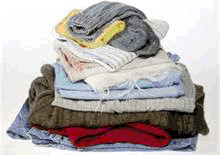 |
RECYCLING TEXTILES II
By Patricia Griffin, President, GHA

The US wholesale recyclers dealing with used textiles are generally buying and selling textiles that are available after charities or resale clothing shops have made an effort to sell the items in the US. These wholesalers are divided pretty clearly into two groups: 1. Used clothing and related items and 2. Wiping cloths and rags. The wholesale companies are generally purchasing massive one-ton bales of mixed fabrics from the charities and paying by the pound. The price will depend upon whether the items have been picked through or are untouched. The charities all expect to be paid when the bales are picked up.
Used clothing is sorted into about 300 categories, baled and sold overseas by the pound where it will all be resold. The recycled textile companies in Africa or Korea, for instance, may contact a US company and order a bale (generally 100 lbs.) each of mens shirts, womens dresses, baby clothing, etc.
When a US wholesale recycling company receives a one-ton bale of mixed clothing items from a charity, the bale must be sorted carefully using eyes and hands, as they say. The sorting can be semi-automatic or automatic, but can only be done using eyes and hands. The semi-automatic version means the large bales are opened and the items are moved by conveyor belt through a group of employees. Each employee has an assignment of a category (i.e., men's shirts) of items they should pull into their barrels or bins. Every item is always checked twice to confirm it is in the correct category and is not blemished with oil, paint, etc.

The automatic systems begin in the same way, but when each employee determines the category of the item, computer buttons are pressed as the item is dropped on a second conveyor belt which has many large bins or cages along its 100+ length. When the categorized items move along the conveyor belt and reach the bin of choice, a blast of air pushes the item off into the correct bin. When a bin is full and orders have been received for that type of item, the bin is moved to the baling area where bales are compressed and prepared for shipment. Once all the bales for a particular order are prepared, they are moved to a container going to that area of the world and then trucked to a port for shipment. The shipment will arrive in 30-60 days, after which the wholesaler will be paid. As you can see, the business requires many employees, huge warehouses (30-100,000+ square feet of covered space), expensive equipment and lots of cash to accomplish their work.
Wiping cloths or rags are cut from clothing deemed not wearable, and made from absorbent fabrics or cotton such as T-shirts, sweatshirts, flannel pajamas, terry towels, etc. They are sold almost exclusively to US manufacturing and service businesses as cleaning and polishing cloths. There are about 70 categories of wiping cloths or rags based on the type and weight of the fabric.

The most important thing for hoteliers to learn about textile recycling is that many companies want to acquire or purchase your hotels retired bed and bath linens as well as unclaimed lost-and-found items. The company will handle the logistics and cost of shipping the textiles. To find a company to purchase or accept your retired linens, go first to greenhotels.com/appvvend.php and look at the LINENS, RECYCLING category. Another choice is smartasn.org.
To see the full-length article in GHA's 8-page newsletter, jump to Pages 7-8.
To learn more about GHA
and how your property can be greener,
jump to Green Hotels Association®!
or CALL 713/789-8889 TODAY!
|

GREEN IDEA!
 A California hotel is serving half glasses of water on request only because full glasses are rarely finished.
A California hotel is serving half glasses of water on request only because full glasses are rarely finished.







|
 |


